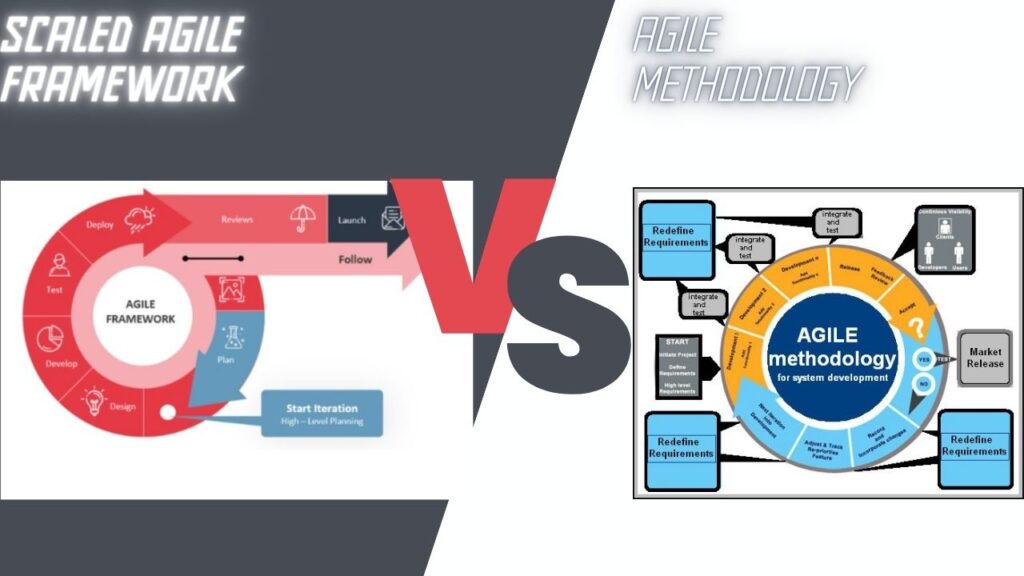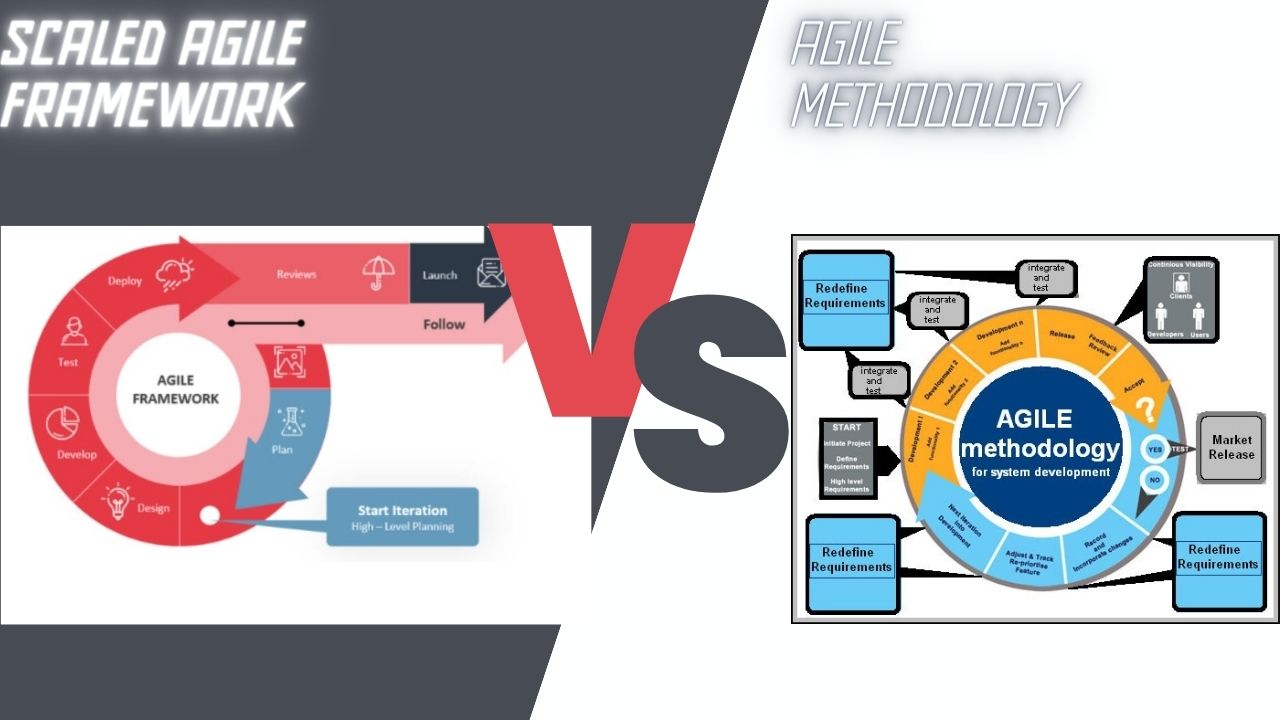Table of Contents
I. Introduction
SAFe Vs Agile methodologies have revolutionized project management by prioritizing adaptability, collaboration, and customer satisfaction. However, as enterprises grapple with the complexities of scaling Agile practices across large organizations, the need for frameworks that provide structure and guidance becomes apparent. This is where (Scaled Agile Framework) emerges as a beacon of innovation, offering a comprehensive approach to Agile at scale.
While both Agile and SAFe share common roots in the Agile Manifesto and principles, they diverge in their approach to scaling Agile practices. Agile, in its purest form, emphasizes flexibility, self-organizing teams, and iterative delivery. It thrives in small to medium-sized projects where teams can quickly respond to change and deliver value incrementally.
On the other hand, SAFe recognizes the challenges of scaling Agile beyond individual teams to encompass large-scale initiatives involving multiple teams, dependencies, and complex value streams. It provides a structured framework that harmonizes Agile practices across the enterprise, ensuring alignment, coordination, and governance while preserving the core principles of Agile.
In this blog, we’ll delve into the nuanced differences between Agile and SAFe, exploring how each approach addresses the unique challenges of enterprise agility. By understanding the distinct characteristics and applications of Agile and SAFe, organizations can make informed decisions about which framework best suits their needs and aspirations for Agile transformation.
A. Brief Overview of SAFe and Agile Methodologies
In today’s rapidly evolving business landscape, the Scaled Agile Framework and Agile methodologies have emerged as essential frameworks for project management and software development.
Agile is an iterative approach to software development that emphasizes collaboration, customer feedback, and flexibility. It breaks down projects into smaller increments called “sprints,” allowing teams to deliver incremental value to stakeholders while continuously adapting to changing requirements.

On the other hand, SAFe is a comprehensive framework designed to scale Agile practices across large enterprises. It provides guidance on coordinating multiple Agile teams, aligning them with business objectives, and fostering a culture of continuous improvement.
B. Importance of Understanding the Differences in Enterprise Settings
Understanding the distinctions between Scaled Agile Framework and Agile is crucial, especially in enterprise settings where complex projects and large-scale transformations are common. Here’s why:
- Scalability: While Agile methodologies work well for small to medium-sized teams, enterprises often face challenges when scaling Agile practices across numerous teams and departments. Scaled Agile Framework addresses this by providing a structured approach to scaling Agile, enabling organizations to coordinate efforts effectively and maintain alignment with overarching business goals.
Example: Consider a multinational corporation with multiple product lines and teams spread across different geographical locations. Implementing Agile at scale without a framework like SAFe could lead to fragmentation, duplication of efforts, and difficulty in prioritizing work. SAFe provides a structured framework for coordinating Agile teams, ensuring consistency, and maximizing the overall efficiency of the organization.*
- Alignment with Business Objectives: Enterprises operate within complex ecosystems where strategic alignment is paramount. While Agile teams focus on delivering value to customers through iterative development, SAFe extends this focus by aligning Agile teams with broader business objectives and ensuring that their efforts contribute to the organization’s overarching goals.
Example: Imagine a financial services company embarking on a digital transformation journey to improve the customer experience and streamline operations. Scaled Agile Framework helps align Agile teams across various departments, such as IT, marketing, and customer service, with the company’s strategic objectives. This alignment ensures that Agile initiatives are prioritized based on their impact on business outcomes, ultimately driving the company towards its digital transformation goals.
In essence, understanding the nuances between Scaled Agile Frameworkand Agile methodologies is vital for enterprises aiming to navigate complex projects, achieve organizational agility, and drive meaningful business results.
II. The Essence of Agile Methodologies
A. Unveiling Agile’s Core DNA: Beyond Buzzwords
In a world where buzzwords dominate discussions around project management and software development, Agile stands out as more than just a trendy term. At its core, Agile embodies a philosophy that transcends methodologies and frameworks, emphasizing a mindset shift towards collaboration, adaptability, and customer-centricity.
- Embracing Uncertainty: Agile as a Philosophy of AdaptationUnlike traditional project management approaches that aim for rigid predictability, Agile acknowledges the inherent uncertainty in complex projects. It embraces change as a natural part of the development process and advocates for iterative, incremental progress. This fundamental principle encourages teams to remain adaptable, constantly refining their approach based on feedback and evolving requirements.Unique Insight: Delve into real-world examples where Agile teams navigated uncertainty with grace, showcasing how embracing change led to innovative solutions and enhanced customer satisfaction.
- Humanizing Development: Agile’s Focus on People and InteractionsAt its heart, Agile is about people. It values collaboration, communication, and trust within teams, recognizing that the collective intelligence of individuals drives project success. Rather than being bound by rigid processes and tools, Agile empowers teams to prioritize meaningful interactions and foster a culture of transparency and empathy.Unique Insight: Share anecdotes or case studies highlighting the transformative power of strong team dynamics in agile environments, illustrating how fostering a culture of psychological safety and inclusivity enhances productivity and creativity.
B. Decoding the Agile Manifesto: Practical Implications for Enterprise Agility
The Agile Manifesto serves as a guiding light for Agile practitioners, offering principles that underpin its philosophy. However, understanding the Manifesto’s practical implications in enterprise contexts requires a deeper dive into its essence and intent.
- From Manifesto to Mindset: Embodying Agile Values in Everyday PracticesBeyond merely reciting the Agile Manifesto, enterprises must internalize its values and principles to drive meaningful change. This entails cultivating a mindset of continuous improvement, where individuals and teams embrace the spirit of collaboration, responsiveness, and customer focus in their daily work.Unique Insight: Explore innovative approaches adopted by enterprises to embed Agile values into their organizational culture, showcasing how initiatives such as gamification, storytelling, or cross-functional collaboration workshops have fostered a shared Agile mindset across diverse teams.
- Beyond Words: Translating Manifesto Principles into Actionable StrategiesWhile the Agile Manifesto provides a philosophical foundation, its true value lies in its application to real-world scenarios. Enterprises must decipher how each Manifesto principle translates into actionable strategies and practices that drive tangible outcomes and business value.Unique Insight: Provide practical tips and strategies for enterprises to align their Agile initiatives with Manifesto principles, offering tailored approaches for overcoming common challenges such as resistance to change, organizational silos, or conflicting priorities.
C. Agile in Enterprise Contexts: Navigating Complexity with Finesse
Implementing Agile in enterprise environments presents unique challenges and opportunities, requiring a nuanced understanding of organizational dynamics and cultural nuances.
- Cultural Evolution: Transforming Organizations from Within Enterprise Agile transformations extend beyond adopting new methodologies; they necessitate a cultural evolution that empowers individuals, fosters collaboration, and promotes a shared sense of purpose. Successful Agile implementations in enterprise contexts hinge on aligning organizational culture with Agile values and principles.Unique Insight: Offer a deep dive into innovative cultural transformation initiatives undertaken by enterprises, highlighting unconventional strategies such as leadership storytelling, experiential learning, or community-building events that have catalyzed Agile adoption at scale.
- Agile Ecosystems: Orchestrating Complexity through Adaptive StructuresEnterprises operate within intricate ecosystems comprising diverse stakeholders, teams, and dependencies. Agile methodologies provide a framework for navigating this complexity by promoting adaptive structures, cross-functional collaboration, and value-driven decision-making.Unique Insight: Showcase how enterprises have leveraged Agile frameworks such as SAFe, LeSS, or Nexus to orchestrate complexity effectively, sharing insights into customizations, pitfalls, and success stories that offer practical guidance for scaling Agile in enterprise contexts.
In essence, Agile methodologies transcend mere procedural frameworks, embodying a philosophy of adaptation, collaboration, and customer-centricity. In enterprise contexts, unlocking the true essence of Agile requires a holistic approach that combines cultural transformation, practical application of Agile principles, and adaptive strategies tailored to the organization’s unique needs and challenges.
III. Unveiling SAFe: Framework for Enterprise Agility
A. Evolution of SAFe and Its Origins
- Tracing the Roots: The Genesis of SAFeSAFe, the Scaled Agile Framework, didn’t emerge overnight. It has a rich history rooted in the collective experiences of Agile practitioners striving to scale Agile practices beyond small teams. Understanding the origins of SAFe sheds light on its evolution and the problems it aims to solve.Unique Insight: Dive into the backstory of SAFe’s creation, exploring how thought leaders like Dean Leffingwell drew inspiration from Lean principles, Agile methodologies, and real-world implementation challenges to develop a scalable framework tailored to enterprise needs.
- From Idea to Impact: SAFe’s Evolutionary JourneySAFe’s journey from concept to widespread adoption is a testament to its relevance and effectiveness in addressing the complexities of enterprise agility. Tracing its evolutionary path offers valuable insights into the framework’s continuous improvement and its responsiveness to changing market dynamics.Unique Insight: Uncover lesser-known anecdotes or pivotal moments in SAFe’s development, showcasing how feedback from early adopters, industry trends, and emerging technologies shaped the framework’s evolution and contributed to its global reach.
B. Key Components and Layers of the SAFe Framework
- Foundations of Scalability: Understanding SAFe’s Structural ComponentsAt its core, SAFe is built on a foundation of principles, values, and practices designed to foster enterprise agility. Exploring its structural components provides a comprehensive understanding of how SAFe orchestrates alignment, collaboration, and value delivery across the organization.Unique Insight: Offer a detailed breakdown of SAFe’s structural elements, including the Big Picture, Agile Release Trains (ARTs), Solution Trains, Essential SAFe, and Full SAFe configurations, highlighting their roles, interactions, and strategic implications for enterprise agility.
- Layers of Agility: Unpacking SAFe’s Hierarchical ModelSAFe adopts a hierarchical model comprising multiple layers, each serving a distinct purpose in orchestrating Agile practices at scale. Delving into these layers elucidates how SAFe bridges the gap between strategic planning, program execution, and team-level delivery within complex enterprise environments.Unique Insight: Explore the intricacies of SAFe’s hierarchical model, uncovering how layers such as Portfolio, Large Solution, Program, and Team synchronize efforts, manage dependencies, and optimize value streams to drive organizational agility and business outcomes.
C. SAFe Principles and How They Align with Agile Values
- Harmony of Principles: SAFe’s Alignment with Agile ValuesSAFe principles serve as guiding beacons, anchoring the framework’s philosophy in Agile values while providing pragmatic guidance for navigating enterprise-scale challenges. Aligning SAFe principles with Agile values illuminates the underlying ethos driving SAFe’s adoption and implementation.Unique Insight: Draw parallels between SAFe’s guiding principles and Agile Manifesto values, illustrating how SAFe preserves the essence of Agile while offering tailored solutions for enterprise contexts. Showcase real-world examples or case studies where SAFe principles have fostered alignment, collaboration, and customer value.
- Beyond Compliance: Embracing Agile Mindset and PracticesSAFe isn’t just about compliance with prescriptive processes; it’s about fostering an Agile mindset that permeates the organization’s culture and practices. Understanding how SAFe principles reinforce Agile values empowers enterprises to embrace agility as a core competency rather than a mere methodology.Unique Insight: Share stories of organizations that have successfully cultivated an Agile mindset through SAFe adoption, highlighting transformative shifts in culture, leadership behavior, and employee engagement. Illustrate how SAFe principles catalyze organizational change and pave the way for sustained agility in dynamic market environments.
In essence, unveiling SAFe goes beyond surface-level exploration; it entails uncovering the framework’s evolutionary journey, structural components, and philosophical underpinnings. By delving into SAFe’s origins, key components, and alignment with Agile values, enterprises gain a deeper appreciation for its role as a transformative framework for achieving enterprise agility in an ever-changing world.
IV. Contrasting SAFe with Traditional Agile
A. Scalability: Addressing Challenges in Large-Scale Projects
- Traditional Agile’s Limitations in ScaleTraditional Agile methodologies like Scrum or Kanban excel in small to medium-sized teams but face scalability challenges when applied to large-scale projects. As project size and complexity increase, coordinating multiple Agile teams, managing dependencies, and ensuring alignment become increasingly difficult.Unique Insight: Illustrate scenarios where traditional Agile approaches struggled to scale effectively, leading to issues such as fragmented delivery, duplicated efforts, and a lack of cross-team coordination, ultimately impacting project outcomes and stakeholder satisfaction.
- SAFe’s Solution: Framework for Scalable AgilitySAFe was specifically designed to address the scalability challenges inherent in large-scale projects. By providing a structured framework that harmonizes Agile practices across multiple teams and levels of the organization, SAFe enables enterprises to scale Agile principles while maintaining alignment with business objectives.Unique Insight: Showcase how SAFe’s principles, practices, and organizational constructs facilitate scalability by promoting standardized processes, cross-team collaboration, and strategic alignment, enabling enterprises to achieve greater efficiency and effectiveness in large-scale projects.
B. Organizational Alignment: Hierarchical vs. Flat Structures
- Traditional Agile’s Emphasis on Flat StructuresTraditional Agile methodologies often favor flat organizational structures characterized by self-organizing teams, minimal hierarchy, and decentralized decision-making. This approach promotes autonomy, collaboration, and empowerment at the team level but may struggle to provide the necessary alignment and coordination in larger organizations.Unique Insight: Explore the benefits and drawbacks of flat organizational structures in Agile contexts, highlighting their potential for fostering innovation and employee engagement while also discussing challenges related to alignment, oversight, and strategic direction.
- SAFe’s Embrace of Hierarchical StructuresIn contrast, SAFe acknowledges the reality of hierarchical structures in large enterprises and provides mechanisms for aligning Agile practices with organizational hierarchy. By introducing roles such as Release Train Engineer (RTE) and providing clear governance and decision-making frameworks, SAFe ensures that Agile practices are seamlessly integrated into the organizational structure.Unique Insight: Provide examples of how SAFe enables enterprises to leverage hierarchical structures to their advantage, facilitating clear accountability, streamlined communication, and strategic alignment across multiple levels of the organization.
C. Roles and Responsibilities: Distribution of Tasks in Enterprise Settings
- Traditional Agile’s Flexible Role DefinitionsTraditional Agile methodologies encourage cross-functional teams with flexible role definitions, where team members collaborate closely and may take on multiple roles as needed. While this approach promotes adaptability and skill diversity, it may lead to ambiguity and inefficiency in larger enterprise settings where clarity of roles and responsibilities is crucial.Unique Insight: Discuss the benefits and challenges of flexible role definitions in Agile teams, drawing on examples of how role ambiguity can impact productivity, accountability, and team dynamics in enterprise environments.
- SAFe’s Defined Roles and ResponsibilitiesSAFe provides clear role definitions and responsibilities tailored to enterprise contexts, ensuring that each role contributes to the overall success of the Agile Release Train (ART) and aligns with organizational objectives. By delineating roles such as Product Owner, Scrum Master, and System Architect, SAFe promotes clarity, accountability, and efficient decision-making within Agile teams.Unique Insight: Highlight how SAFe’s defined roles and responsibilities contribute to improved clarity, alignment, and coordination in enterprise Agile initiatives, enabling teams to work more effectively towards common goals and deliver value to stakeholders with greater predictability and transparency.
V. Flexibility vs. Standardization: Harmonizing Adaptability and Consistency
A. Agile’s Emphasis on Flexibility and Adaptability
- Embracing the Winds of Change: Agile’s Dynamic ApproachAgile methodologies dance to the rhythm of change, weaving flexibility and adaptability into the very fabric of project management. Unlike traditional approaches, Agile embraces uncertainty as a friend rather than a foe, allowing teams to pivot swiftly in response to evolving requirements and market dynamics.Unique Insight: Explore how Agile teams harness the power of uncertainty, showcasing instances where adaptability led to breakthrough innovations or unexpected successes. Highlight the role of Agile ceremonies like Sprint Reviews and Daily Standups in fostering real-time collaboration and course correction.
- Autonomy: Agile’s Secret Sauce for InnovationOne of Agile’s most potent ingredients is autonomy, empowering teams to make decisions autonomously and take ownership of their work. By decentralizing decision-making and fostering a culture of trust, Agile unleashes the creative potential of individuals, driving innovation and problem-solving at the grassroots level.Unique Insight: Share anecdotes of Agile teams that embraced autonomy to challenge the status quo and disrupt industry norms. Highlight how organizations like Spotify or Valve have redefined traditional hierarchies, fostering environments where creativity flourishes and experimentation is celebrated.
B. SAFe’s Focus on Standardization and Alignment Across Teams
- Navigating the Sea of Complexity: SAFe’s Beacon of StandardizationIn the stormy seas of large-scale projects, SAFe serves as a lighthouse, guiding organizations with its beacon of standardization and alignment. By establishing common practices, roles, and ceremonies, SAFe provides a framework for harmonizing efforts across diverse teams and departments, ensuring consistency and cohesion.Unique Insight: Delve into case studies of organizations that successfully implemented SAFe, showcasing how standardization fostered clarity, reduced ambiguity, and enhanced collaboration. Highlight specific SAFe practices such as PI Planning or System Demos that promoted alignment and synergy across the enterprise.
- The Art of Alignment: SAFe’s Symphony of CollaborationSAFe orchestrates a symphony of collaboration, harmonizing Agile Release Trains (ARTs) and value streams to play in unison towards common objectives. By fostering cross-functional collaboration and shared accountability, SAFe enables organizations to achieve coherence and alignment at scale, driving value delivery with precision.Unique Insight: Illustrate how SAFe encourages cross-pollination of ideas and expertise across ARTs, fostering a culture of knowledge-sharing and collective problem-solving. Highlight examples of successful SAFe implementations where collaboration flourished, leading to breakthrough innovations and transformative outcomes.
C. Finding the Right Balance for Enterprise Agility
- Walking the Tightrope: Balancing Flexibility and StandardizationAchieving enterprise agility requires walking a tightrope between flexibility and standardization, maintaining equilibrium in the face of complexity and change. While Agile thrives on adaptability, SAFe provides guardrails for alignment, enabling organizations to navigate uncertainty with confidence while preserving agility.Unique Insight: Offer practical strategies for finding the right balance between flexibility and standardization, such as customizing SAFe to fit organizational needs, fostering a culture of experimentation and learning, and promoting adaptive leadership practices that embrace uncertainty.
- Continuous Harmonization: Embracing Change as a SymphonyJust as a symphony evolves with each performance, enterprise agility requires continuous harmonization and refinement. By embracing change as a natural part of the journey, organizations can cultivate a culture of continuous improvement and learning, ensuring that they remain agile and resilient in the face of disruption.Unique Insight: Share stories of organizations that embraced continuous harmonization, celebrating failures as opportunities for growth and innovation. Highlight how feedback loops, retrospectives, and adaptive governance structures enable organizations to course-correct and iterate towards excellence.
In summary, achieving enterprise agility entails harmonizing flexibility and standardization, leveraging the strengths of Agile and SAFe frameworks to navigate complexity and change with grace. By embracing a culture of autonomy, collaboration, and continuous improvement, organizations can orchestrate symphonies of innovation and drive transformative outcomes in an ever-evolving world.
VI. Challenges and Benefits of Implementing SAFe in Enterprises
A. Overcoming Resistance to Change and Organizational Inertia
- The Tug-of-War with Change: Navigating Organizational ResistanceImplementing SAFe in enterprises often encounters resistance from entrenched processes, cultural inertia, and fear of the unknown. Overcoming this resistance requires effective change management strategies that address concerns, build buy-in, and foster a shared vision of the benefits of SAFe adoption.Unique Insight: Explore unconventional tactics for addressing resistance to change, such as gamification, storytelling, or peer-to-peer coaching. Share real-life examples of organizations that successfully navigated resistance by fostering transparency, communication, and employee empowerment.
- Breaking Down Silos: Bridging Organizational DividesOrganizational silos pose a significant barrier to SAFe implementation, hindering collaboration, information sharing, and alignment across departments. Overcoming silos requires a holistic approach that promotes cross-functional collaboration, shared accountability, and a culture of transparency and openness.Unique Insight: Showcase innovative approaches for breaking down silos, such as cross-functional workshops, job rotations, or leadership shadowing programs. Highlight case studies of organizations that transformed siloed structures into interconnected networks, fostering synergy and alignment across the enterprise.
B. Realizing the Benefits of Improved Collaboration and Efficiency
- Unlocking the Power of Collaboration: Driving Value Through TeamworkOne of the key benefits of SAFe implementation is improved collaboration across teams, departments, and business units. By fostering cross-functional collaboration and shared ownership of outcomes, SAFe enables organizations to leverage collective intelligence, drive innovation, and deliver value more effectively.Unique Insight: Highlight the transformative impact of collaboration on organizational performance, showcasing examples of how SAFe implementation led to breakthrough innovations, streamlined processes, and accelerated time-to-market. Illustrate how SAFe ceremonies such as PI Planning or Inspect and Adapt workshops promote collaboration and alignment.
- Efficiency in Motion: Streamlining Processes for Maximum ImpactSAFe implementation streamlines processes, eliminates waste, and optimizes value streams, resulting in increased efficiency and productivity. By standardizing practices, reducing dependencies, and fostering continuous improvement, SAFe enables organizations to achieve operational excellence and deliver value with greater predictability.Unique Insight: Offer insights into how SAFe principles such as Lean thinking, flow, and cadence optimization drive efficiency and effectiveness in enterprise settings. Share success stories of organizations that realized significant efficiency gains through SAFe implementation, achieving cost savings, improved quality, and enhanced customer satisfaction.
C. Case Studies or Examples of Successful SAFe Implementations in Enterprises
- Leading by Example: Showcasing SAFe Success StoriesReal-world examples of successful SAFe implementations serve as inspiration and guidance for organizations embarking on their Agile journey. Case studies highlight best practices, lessons learned, and tangible outcomes achieved through SAFe adoption, offering valuable insights and benchmarks for success.Unique Insight: Curate a collection of case studies from diverse industries and organizational contexts, showcasing the versatility and scalability of SAFe across different domains. Highlight success factors, challenges overcome, and key takeaways from each case study, providing actionable insights for organizations considering SAFe adoption.
- Voices from the Trenches: Lessons Learned from SAFe PioneersBeyond success stories, the voices of SAFe pioneers offer invaluable wisdom and perspective on the challenges and triumphs of Agile transformation. By sharing their experiences, insights, and practical tips, SAFe practitioners provide guidance and support for organizations navigating their Agile journey.Unique Insight: Interview SAFe practitioners, Agile coaches, and organizational leaders who have firsthand experience with SAFe implementation. Capture their stories, anecdotes, and reflections on the highs and lows of Agile transformation, offering candid insights and actionable advice for organizations embarking on their Agile journey.
VII. Key Considerations for Choosing Between SAFe and Agile
A. Project Scope and Scale: Assessing the Size and Complexity of Initiatives
- Understanding Project Dynamics: Scope, Scale, and ComplexityWhen choosing between SAFe and Agile, it’s essential to assess the unique characteristics of the project, including its scope, scale, and complexity. Agile methodologies like Scrum or Kanban may be suitable for smaller, less complex projects with clear requirements and minimal dependencies. In contrast, SAFe excels in managing large-scale initiatives involving multiple teams, intricate dependencies, and enterprise-wide impact.Unique Insight: Offer a framework for evaluating project scope and scale, considering factors such as team size, geographic distribution, stakeholder involvement, and regulatory requirements. Provide real-world examples of projects that benefited from SAFe’s scalability or Agile’s flexibility, showcasing how alignment with project dynamics drives success.
- Matching Framework to Project Needs: Tailoring Approach for SuccessOnce project dynamics are understood, organizations can align their choice of framework with the specific needs and objectives of the initiative. Agile methodologies offer agility and adaptability, making them well-suited for projects requiring rapid iteration and customer feedback. In contrast, SAFe provides structure and governance, making it ideal for managing large-scale transformations and ensuring alignment with organizational goals.Unique Insight: Share insights from Agile and SAFe practitioners who have navigated diverse project landscapes, highlighting the thought process behind selecting the appropriate framework for each scenario. Discuss how customizations or hybrid approaches can bridge the gap between Agile and SAFe, maximizing the benefits of both frameworks.
B. Organizational Culture and Readiness: Evaluating Readiness for Agile Transformation
- Assessing Organizational DNA: Culture, Mindset, and BehaviorsSuccessful Agile transformation requires more than just implementing a framework—it demands a cultural shift that embraces collaboration, transparency, and continuous improvement. Organizations must assess their readiness for Agile transformation by evaluating cultural attributes such as leadership support, empowerment, risk tolerance, and openness to change.Unique Insight: Offer a diagnostic tool or assessment framework for organizations to evaluate their cultural readiness for Agile transformation. Share case studies of organizations that successfully cultivated Agile-friendly cultures, highlighting strategies for overcoming resistance, building trust, and fostering a growth mindset.
- Charting the Path to Agility: Roadmap, Training, and Change ManagementOnce organizational readiness is assessed, organizations can develop a roadmap for Agile transformation that addresses key areas such as leadership development, team empowerment, skills training, and change management. By investing in education, coaching, and support mechanisms, organizations can accelerate the adoption of Agile practices and sustain long-term transformation.Unique Insight: Showcase examples of organizations that implemented comprehensive Agile transformation programs, detailing the roadmap, milestones, and key initiatives that drove success. Highlight innovative approaches to change management, such as peer coaching, communities of practice, or Agile maturity assessments, that fostered cultural change and adoption.
C. Long-term Strategy: Aligning Frameworks with Business Goals and Objectives
- Connecting Frameworks to Business Imperatives: Strategic AlignmentChoosing between SAFe and Agile requires a deep understanding of the organization’s long-term strategy, goals, and objectives. Organizations must align their choice of framework with strategic priorities such as innovation, customer experience, time-to-market, or regulatory compliance, ensuring that Agile practices support broader business imperatives.Unique Insight: Illustrate the importance of strategic alignment by showcasing examples of organizations that tailored their Agile approach to align with specific business goals. Discuss how SAFe’s focus on value delivery and business agility can drive strategic outcomes, enabling organizations to respond effectively to market dynamics and customer needs.
- Evolving with the Business Landscape: Flexibility and AdaptabilityIn today’s rapidly changing business landscape, organizations must remain agile and adaptable to stay ahead of the curve. Choosing between SAFe and Agile is not a one-time decision but an ongoing journey that requires flexibility and responsiveness to changing market conditions, emerging technologies, and evolving customer preferences.Unique Insight: Offer guidance on future-proofing Agile transformation by embracing principles of adaptability, experimentation, and continuous learning. Share examples of organizations that iteratively refined their Agile approach in response to shifting business priorities, demonstrating the importance of agility in driving sustained success.
In conclusion, choosing between SAFe and Agile requires careful consideration of project dynamics, organizational culture, and long-term strategic objectives. By aligning the choice of framework with project needs, cultural readiness, and business goals, organizations can pave the way for successful Agile transformation and drive meaningful outcomes in an increasingly complex and dynamic business environment.
VIII. Best Practices for Integrating SAFe and Agile in Enterprise Environments
A. Tailoring SAFe Practices to Fit Organizational Needs
- Customization Over Compliance: Adapting SAFe to Organizational ContextInstead of blindly adhering to SAFe practices, enterprises should focus on tailoring the framework to suit their unique organizational needs and constraints. This involves conducting a thorough assessment of existing processes, culture, and project dynamics to identify areas where SAFe practices can be customized for maximum effectiveness.Unique Insight: Provide case studies or examples of organizations that successfully customized SAFe practices to align with their specific context. Highlight how flexibility and adaptability in implementing SAFe led to improved outcomes, enhanced collaboration, and greater stakeholder satisfaction.
- Agile Portfolio Management: Balancing Flexibility and GovernanceSAFe’s Agile Portfolio Management provides a structured approach for aligning portfolio strategy with execution, ensuring that investment decisions are based on business value and strategic objectives. However, organizations must strike a balance between flexibility and governance, tailoring portfolio management practices to accommodate changing priorities and market dynamics.Unique Insight: Share innovative approaches to Agile Portfolio Management adopted by organizations, such as dynamic budgeting, capacity-based planning, or value stream mapping. Illustrate how these practices enable organizations to optimize resource allocation, mitigate risks, and capitalize on emerging opportunities.
B. Creating Cross-Functional Teams and Fostering Collaboration
- Breaking Down Silos: Building Agile Release Trains (ARTs)SAFe’s Agile Release Trains (ARTs) bring together cross-functional teams aligned around a common mission or value stream, fostering collaboration, alignment, and shared accountability. However, creating ARTs requires careful consideration of team composition, skill sets, and dependencies to ensure that they are truly cross-functional and capable of delivering value independently.Unique Insight: Provide insights into the ART formation process, highlighting strategies for selecting team members, defining ART boundaries, and managing dependencies. Showcase examples of organizations that successfully established ARTs, showcasing the benefits of cross-functional collaboration and collective ownership.
- Cultivating Communities of Practice: Fostering Knowledge Sharing and LearningCommunities of Practice (CoPs) provide a forum for practitioners to share knowledge, exchange ideas, and collaborate on common challenges. By cultivating CoPs within the organization, enterprises can tap into the collective wisdom of their teams, accelerate learning, and drive continuous improvement.Unique Insight: Showcase examples of successful CoPs within organizations, highlighting how they facilitate knowledge sharing, mentorship, and skill development. Discuss the role of CoPs in fostering a culture of innovation, experimentation, and collaboration, ultimately driving organizational agility and resilience.
C. Continuous Improvement: Iterative Refinement of Processes and Practices
- Inspect and Adapt: Embracing a Culture of Continuous ImprovementSAFe’s Inspect and Adapt (I&A) workshop provides a structured forum for teams to reflect on their performance, identify areas for improvement, and develop action plans for driving change. By embracing a culture of continuous improvement, organizations can iterate on their processes and practices to enhance efficiency, quality, and customer value.Unique Insight: Offer insights into the Inspect and Adapt process, highlighting best practices for conducting effective workshops, capturing actionable insights, and driving meaningful change. Share examples of organizations that leveraged I&A workshops to address bottlenecks, improve collaboration, and deliver better outcomes.
- Kaizen Mindset: Empowering Teams to Drive ChangeThe Kaizen mindset, rooted in the principles of continuous improvement and incremental change, empowers teams to take ownership of their processes and drive meaningful improvements over time. By fostering a culture of experimentation, learning, and adaptation, organizations can harness the collective intelligence of their teams to drive sustainable change.Unique Insight: Showcase examples of organizations that embraced the Kaizen mindset, highlighting how small, incremental changes led to significant improvements in productivity, quality, and customer satisfaction. Discuss the role of leadership in nurturing a culture of experimentation and continuous learning, ultimately driving organizational agility and resilience.
In conclusion, integrating SAFe and Agile in enterprise environments requires a thoughtful approach that balances standardization with flexibility, fosters collaboration and cross-functional teamwork, and embraces a culture of continuous improvement and learning. By tailoring SAFe practices to fit organizational needs, creating cross-functional teams, and driving iterative refinement of processes and practices, organizations can unlock the full potential of Agile at scale and drive meaningful business outcomes.



